Thursday, February 28, 2008
Tuesday, February 26, 2008
Wildlife & Adventure
Wildlife & Adventure
Kathmandu : Kathmandu Durbar , The big bell , Kathmandu valley , Tibetan monasteries , Buddhist temples , Pashupatinath , Boudhnath Stupa , Patan.
Pokhara : Machhapuchhre , Phewa lake , Sarankot Hill , Mt. Dhaulagiri. , Mt. Annapurna , Lamjung Himalaya .
Chitwan : Royal Chitwan National Park .
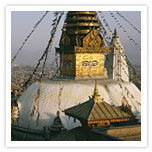 Day 01. ARRIVE KATHMANDU
Day 01. ARRIVE KATHMANDU Upon arrival at Kathmandu airport, you will be met, assisted and escorted to your hotel by our representative.
After checking in, you can relax for sometime and later in the afternoon proceed for half day sightseeing of Kathmandu city and Swoyambhunath Stupa.
Kathmandu City: Kathmandu Durbar with its medley of temples and shrines is the traditional seat of the royalty where Kings are crowned and their coronations are performed. The big bell; Kal Bhairav Temple; Jagannath Temple with its erotic carvings on the temple struts; Kasthamandap - the temple believed to have been built from the wood of a single tree and from which the city of Kathmandu derives its name, are some views you will enjoy on this tour. But on top of the list is the Kumari Ghar - the temple of the living goddess. For most of the year, the Kumari is available to greet people from the balcony of the temple. Photography is strictly prohibited here. Spend some time browsing through a typical Nepalese market place.
Swoyambhunath Stupa: These 2000 years old stupas are situated approx. 1.8 miles west of Kathmandu on a hillock overlooking the Kathmandu valley. This is one of the most glorious Buddhist temples. It is decorated with the famous "Buddha's eyes", and is surrounded by temples and Tibetan monasteries.
Stay overnight in Kathmandu.
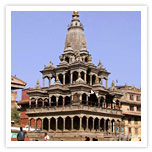 Day 02. IN KATHMANDU
Day 02. IN KATHMANDUAfter an early breakfast proceed for half day sightseeing of Pashupatinath and Boudhnath.
Pashupatinath: Lying on the banks of the sacred Bagmati River, this is the country's most important Hindu temple, dedicated to Lord Shiva. It was built in 1696 with a two-tiered golden roof and silver doors and is famous for its superb architecture. Each year it draws numerous devotees from all over India.
Boudhnath Stupa: It lies approx. 5 miles east of Kathmandu. This is one of the largest Buddhist Shrines in the world, dating before the birth of Christ. It is the religious centre for Nepal's considerable population of Tibetans and there are a number of thriving monasteries. This area is also referred to as 'little Tibet'.
In the afternoon visit Patan City.
Patan: Also known as Lalitpur meaning city of devotees, is where you will visit the Patan Durbar Square with its exquisite architectural masterpieces depicting the Newar craftsmanship. Krishna Mandir - a stone structure with 21 spires; Hiranya Varan Mahabihar - the Golden temple; and Mahaboudha - a masterpiece in terra cotta, are some of the other highlights of the tour. After the tour you will continue to the Tibetan Resettlement Camp where Tibetan refugees are rehabilitated. You will see women weaving carpets on their looms.
Stay overnight in Kathmandu.
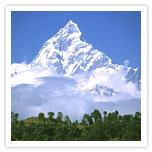 Day 03. KATHMANDU - POKHRA
Day 03. KATHMANDU - POKHRAAfter an early breakfast proceed by surface to Pokhra.
Pokhra is situated approx. 131 miles east of Kathmandu and is one of the most scenic spots in the country. The Himalayan panorama of the Annapurna range with the dominating peak of Machhapuchhre (Fish Tail) forming the backdrop for the city is a sight to behold. There are many lakes in Pokhra, the major being Phewa lake which is situated on the southernmost point of the city and is a popular tour spot.
Relax in the afternoon and later in the evening enjoy a boat ride on Phewa Lake.
Stay overnight in Pokhra.
Day 04. IN POKHRA
After an early morning breakfast enjoy a pleasant walk up to the top of the Sarankot Hill, at an elevation of 950mts. The trail continues north from the lakeside and follows the stream along rice fields and then goes uphill through the forest with the accompaniment of birds chirping in the trees. Once on top, you will have an amazing view of Mt. Dhaulagiri, Annapurna, Lamjung Himalaya and many other peaks.
Come down the same way you went up Sarankot Hill.
Rest of the day at leisure.
Stay overnight in Pokhra.
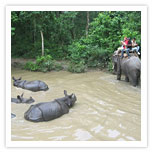 Day 05. POKHRA - CHITWAN
Day 05. POKHRA - CHITWANThis morning after breakfast drive down to Chitwan.
Nepal is blessed with a greater proportion of protected wilderness that almost any other country on earth, and boasts of a multitude of national parks and wildlife reserves.
Royal Chitwan National Park ('Chitwan' means "in the heart of the jungle") covers 932 sq. km in the flat lowland (Terai) region of southern Nepal. It is one of the most important sub-tropical parks on the Indian subcontinent with populations of the endangered royal Bengal tigers (Panthera tigris), one-horned rhinoceros (Rhinoceros unicornis), Gangetic dolphin (Platanista gangetica), wild Asian elephant (Elaphas maximus), gaur (wild ox - Bos gaurus), golden monitor lizard, gharial crocodile (Gavializ gangeticus) and many more.
The relatively pristine state of the modern park and its unique ecosystem prompted UNESCO to declare the park a World Heritage site in 1984.
In the afternoon enjoy your first safari into the jungle.
Stay overnight in Chitwan.
Day 06. IN CHITWAN
The entire day spent in the jungle, enjoy the safaris and other activities on offer.
Stay overnight in Chitwan.
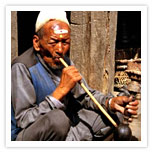
Best of nepal
Best of Nepal
Kathmandu : Kathmandu Durbar , The big bell , Kathmandu valley , Tibetan monasteries , Buddhist temples , Pashupatinath , Boudhnath Stupa , Patan.
Pokhara : Machhapuchhre , Phewa lake , Sarankot Hill , Mt. Dhaulagiri. , Mt. Annapurna , Lamjung Himalaya .
Chitwan : Royal Chitwan National Park .
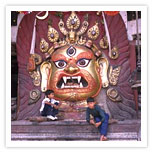 Day 01. ARRIVE KATHMANDU
Day 01. ARRIVE KATHMANDUUpon arrival at Kathmandu airport, you will be met, assisted and escorted to your hotel by our representative.
After checking in relax for sometime and later in the afternoon proceed for half day sightseeing of Kathmandu city and Swoyambhunath Stupa.
Kathmandu City: Kathmandu Durbar with its medley of temples and shrines is the traditional seat of the royalty where Kings are crowned and their coronations are performed. The big bell; Kal Bhairav Temple; Jagannath Temple with its erotic carvings on the temple struts; Kasthamandap - the temple believed to have built from the wood of a single tree and from which the city of Kathmandu derives its name, are some views you will enjoy on this tour. But on top of the list is the Kumari Ghar - the temple of the living goddess. For most of the year, the Kumari is available to greet people from the balcony of the temple. Photography is strictly prohibited here. Spend some time browsing through a typical Nepalese market place.
Swoyambhunath Stupa: These 2000 years old stupas are situated approx. 1.8 miles west of Kathmandu on a hillock overlooking the Kathmandu valley. This is one of the most glorious Buddhist temples. It is decorated with the famous "Buddha's eyes", and is surrounded by temples and Tibetan monasteries. This day you can relax or just walk around on your own to get the feel of the city.
Stay overnight in Kathmandu.
Day 02. IN KATHMANDU
After the breakfast proceed for half day sightseeing of Pashupatinath and Boudhnath.
Pashupatinath: Lying on the banks of the sacred Bagmati River, this is the country's most important Hindu temple, dedicated to Lord Shiva. It was built in 1696 with two-tiered golden roof and silver doors and is famous for its superb architecture. Each year it draws numerous devotees from all over India.
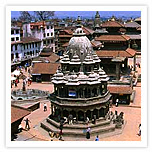
Boudhnath Stupa: It lays approx. 5 miles east of Kathmandu. This is one of the largest Buddhist Shrines in the world, dating before the birth of Christ. It is the religious centre for Nepal's considerable population of Tibetans and there are a number of thriving monasteries. This area is also referred to as 'little Tibet'.
In the afternoon visit Patan City.
Patan: Also known as Lalitpur meaning city of devotees, is where you will visit the Patan Durbar Square with its exquisite architectural masterpieces depicting the Newar craftsmanship. Krishna Mandir - a stone structure with 21 spires; Hiranya Varan Mahabihar - the Golden temple; and Mahaboudha - a masterpiece in terra cotta, are some of the other highlights of the tour. After the tour you will continue to the Tibetan Resettlement Camp where Tibetan Refugees are rehabilitated. You will see women weaving carpets on the their looms.
Stay overnight in Kathmandu.
Day 03. KATHMANDU - NAGARKOT VIA BHAKTAPUR
After an early breakfast proceed towards Nagarkot via Bhadgaon city (Bhaktapur).
Bhadgaon City: It is situated approx. 10 miles from Kathmandu and has an impressive number of artistic treasures. Rightly called 'a living museum', is the most mediaeval city of the valley. It is situated at an altitude of 1401mts. Bhaktapur means the city of devotees. Pottery and weaving are its traditional industries. The Bhadgaon city, one of the oldest medieval cities, was the capital of Kathmandu valley during the Malla dynasty until the 15th century.
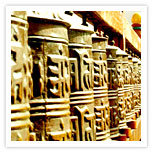
Nagarkot is approx. 21 miles north east of Kathmandu at an altitude of 2175mts above sea level. The panorama of the major peaks of the eastern Himalayas including Mt. Everest can be seen from here.
Upon arrival proceed to the hotel and check in. Later go out and view the amazing sunset.
Stay overnight in Nagarkot.
Day 04. NAGARKOT - POKHRA
Early morning walk to a point to view the majestic sunrise. Return to hotel for breakfast and then continue your drive to Pokhra.
Pokhra is situated approx. 131 miles east of Kathmandu and is one of the most scenic spots in the country. The Himalayan panorama of the Annapurna range with the dominating peak of Machhapuchhre (Fish Tail) forming the backdrop for the city is a sight to behold. There are many lakes in Pokhra, the major being Phewa lake which is situated on the southernmost point of the city and is a popular tour spot.
Relax in the afternoon and later in the evening enjoy a boat ride on Phewa Lake.
Stay overnight in Pokhra.
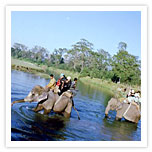 Day 05. POKHRA - CHITWAN
Day 05. POKHRA - CHITWANThis morning after breakfast drive down to Chitwan.
Nepal is blessed with a greater proportion of protected wilderness that almost any other country on earth, and boasts of a multitude of national parks and wildlife reserves.
Royal Chitwan National Park ('Chitwan' means "in the heart of the jungle") covers 932 sq. km in the flat lowland (Terai) region of southern Nepal. It is one of the most important sub-tropical parks on the Indian subcontinent with populations of the endangered royal Bengal tigers (Panthera tigris), one-horned rhinoceros (Rhinoceros unicornis), Gangetic dolphin (Platanista gangetica), wild Asian elephant (Elaphas maximus), gaur (wild ox - Bos gaurus), golden monitor lizard, gharial crocodile (Gavializ gangeticus) and many more.
The relatively pristine state of the modern park and its unique ecosystem prompted UNESCO to declare the park a World Heritage site in 1984.
In the afternoon enjoy your first safari into the jungle.
Stay overnight in Chitwan.
Day 06. IN CHITWAN
The entire day spent in the jungle, enjoy the safaris and other activities on offer.
Stay overnight in Chitwan.
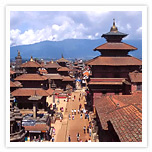
Day 07. CHITWAN - KATHMANDU
After an early morning breakfast, drive back to Kathmandu.
After checking in at the hotel the rest of the day is free to relax at the hotel or explore the city center.
Stay overnight in Kathmandu.
Day 08. LEAVE KATHMANDU
Explore kathmandu
Explore Kathmandu
Kathmandu : Kathmandu Durbar , The big bell , Kathmandu valley , Tibetan monasteries , Buddhist temples , Pashupatinath , Boudhnath Stupa , Patan.
 The Kathmandu valley is the cultural and artistic heart of Nepal, and contains some of the oldest and best-preserved cities in the world: Kathmandu, Patan and Bhaktapur. The historical, cultural and artistic importance is so immense that UNESCO has designated no less than seven World Heritage Sites here, all of which our guests may enjoy at their leisure.
The Kathmandu valley is the cultural and artistic heart of Nepal, and contains some of the oldest and best-preserved cities in the world: Kathmandu, Patan and Bhaktapur. The historical, cultural and artistic importance is so immense that UNESCO has designated no less than seven World Heritage Sites here, all of which our guests may enjoy at their leisure.Day 01. ARRIVE KATHMANDU
You could arrive into Kathmandu directly from Europe or take a connection through either India or the Far East. Upon arrival at Kathmandu airport, you will be met, assisted and escorted to your hotel by our representative.
After checking in, you can relax or just walk around on your own to get the feel of the city.
Stay overnight in Kathmandu.
Day 02. IN KATHMANDU
 After breakfast proceed for half day sightseeing of Kathmandu city and Swoyambhunath Stupa.
After breakfast proceed for half day sightseeing of Kathmandu city and Swoyambhunath Stupa.Kathmandu City: Kathmandu Durbar with its medley of temples and shrines is the traditional seat of the royalty where Kings are crowned and their coronations are performed. The big bell; Kal Bhairav Temple; Jagannath Temple with its erotic carvings on the temple struts; Kasthamandap - the temple believed to have built from the wood of a single tree and from which the city of Kathmandu derives its name, are some views you will enjoy on this tour. But on top of the list is the Kumari Ghar - the temple of the living goddess. For most of the year, the Kumari is available to greet people from the balcony of the temple. Photography is strictly prohibited here. Spend some time browsing through a typical Nepalese market place.
Swoyambhunath Stupa: These 2000 years old stupas are situated approx. 1.8 miles west of Kathmandu on a hillock overlooking the Kathmandu valley. This is one of the most glorious Buddhist temples. It is decorated with the famous "Buddha's eyes", and is surrounded by temples and Tibetan monasteries. Today you can relax or explore on your own.
In the afternoon visit Patan City.
Patan: Also known as Lalitpur meaning city of devotees is where you will visit the Patan Durbar Square with its exquisite architectural masterpieces depicting the Newar craftsmanship. Krishna Mandir - a stone structure with 21 spires; Hiranya Varan Mahabihar - the Golden temple; and Mahaboudha - a masterpiece in terra cotta, are some of the other highlights of the tour. After the tour you will continue to the Tibetan Resettlement Camp where Tibetan Refugees are rehabilitated. You will see women weaving carpets on the their looms.
 Stay overnight in Kathmandu.
Stay overnight in Kathmandu.Day 03. IN KATHMANDU
After an early breakfast proceed for half day sightseeing of Pashupatinath and Boudhnath.
Pashupatinath: Lying on the banks of the sacred Bagmati River, this is the country's most important Hindu temple, dedicated to Lord Shiva. It was built in 1696 with a two-tiered golden roof and silver doors and is famous for its superb architecture. Each year it draws numerous devotees from all over India.
Boudhnath Stupa: It lays approx. 5 miles east of Kathmandu. This is one of the largest Buddhist shrines in the world, dating before the birth of Christ. It is the religious centre for Nepal's considerable population of Tibetans and there are a number of thriving monasteries. This area is also referred to as 'little Tibet'.
In the afternoon visit Bhadgaon city.
Bhadgaon City: It is situated approx. 10 miles from Kathmandu and has an impressive number of artistic treasures. Rightly called 'a living museum', it is the most medieval city of the valley. It is situated at an altitude of 1401mts. Bhaktapur means the city of devotees. Pottery and weaving are its traditional industries. The Bhadgaon city one of the oldest medieval cities was the capital of Kathmandu valley during the Malla dynasty, until the 15th century.
Stay overnight in Kathmandu.
Beautiful nepal
Beautiful Nepal (07 Days)
Kathmandu : Kathmandu Durbar , The big bell , Kathmandu valley , Tibetan monasteries , Buddhist temples , Pashupatinath , Boudhnath Stupa , Patan.
Pokhara : Machhapuchhre , Phewa lake , Sarankot Hill , Mt. Dhaulagiri. , Mt. Annapurna , Lamjung Himalaya .
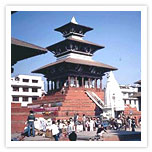 Day 01. ARRIVE KATHMANDU
Day 01. ARRIVE KATHMANDUUpon arrival at Kathmandu airport, you will be met, assisted and escorted to your hotel by our representative.
After checking in, you can relax for sometime and later in the afternoon proceed for half day sightseeing of Kathmandu city and Swoyambhunath Stupa.
Kathmandu City: Kathmandu Durbar with its medley of temples and shrines is the traditional seat of the royalty where Kings are crowned and their coronations are performed. The big bell; Kal Bhairav Temple; Jagannath Temple with its erotic carvings on the temple struts; Kasthamandap - the temple believed to have been built from the wood of a single tree and from which the city of Kathmandu derives its name, are some views you will enjoy on this tour. But on top of the list is the Kumari Ghar - the temple of the living goddess. For most of the year, the Kumari is available to greet people from the balcony of the temple. Photography is strictly prohibited here. Spend some time browsing through a typical Nepalese market place.
Swoyambhunath Stupa: These 2000 years old stupas are situated approx. 1.8 miles west of Kathmandu on a hillock overlooking the Kathmandu valley. This is one of the most glorious Buddhist temples. It is decorated with the famous "Buddha's eyes", and is surrounded by temples and Tibetan monasteries.
Stay overnight in Kathmandu.
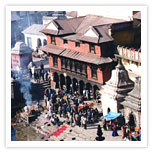 Day 02. IN KATHMANDU
Day 02. IN KATHMANDUPashupatinath: Lying on the banks of the sacred Bagmati River, this is the country's most important Hindu temple, dedicated to Lord Shiva. It was built in 1696 with a two-tiered golden roof and silver doors and is famous for its superb architecture. Each year it draws numerous devotees from all over India.
Boudhnath Stupa: It lies approx. 5 miles east of Kathmandu. This is one of the largest Buddhist Shrines in the world, dating before the birth of Christ. It is the religious centre for Nepal's considerable population of Tibetans and there are a number of thriving monasteries. This area is also referred to as 'little Tibet'.
In the afternoon visit Patan City.
Patan: Also known as Lalitpur meaning city of devotees, is where you will visit the Patan Durbar Square with its exquisite architectural masterpieces depicting the Newar craftsmanship. Krishna Mandir - a stone structure with 21 spires; Hiranya Varan Mahabihar - the Golden temple; and Mahaboudha - a masterpiece in terra cotta, are some of the other highlights of the tour. After the tour you will continue to the Tibetan Resettlement Camp where Tibetan refugees are rehabilitated. You will see women weaving carpets on their looms.
Stay overnight in Kathmandu.
Day 03. KATHMANDU - NAGARKOT VIA BHAKTAPUR
Bhadgaon City: It is situated approx. 10 miles from Kathmandu and has an impressive number of artistic treasures. The most medieval city of the valley, it is rightly called 'a living museum.' It is situated at an altitude of 1401mts. Bhaktapur means the city of devotees. Pottery and weaving are its traditional industries. The Bhadgaon city, one of the oldest medieval cities was the capital of Kathmandu valley during the Malla dynasty, until the 15th century.
Nagarkot is approx. 21 miles northeast of Kathmandu at an altitude of 2175mts above sea level. The panorama of the major peaks of eastern Himalayas including Mt. Everestcan be seen from here.
Upon arrival proceed to the hotel and check in. Later go out and view the amazing sunset.
Stay overnight in Nagarkot.
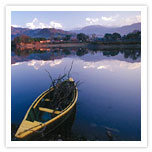 Day 04. NAGARKOT - POKHRA
Day 04. NAGARKOT - POKHRAEarly morning walk to a point to view the majestic sunrise. Return to hotel for breakfast and then continue your drive to Pokhra.
Pokhra is situated approx. 131 miles east of Kathmandu and is one of the most scenic spots in the country. The Himalayan panorama of the Annapurna range with the dominating peak of Machhapuchhre (Fish Tail) forming the backdrop to the city is a sight to behold. There are many lakes in Pokhra, the major being Phewa lake which is situated on the southernmost point of the city and is a popular tour spot.
Relax in the afternoon and later in the evening enjoy a boat ride on Phewa Lake.
Stay overnight in Pokhra.
Day 05. IN POKHRA
After an early morning breakfast enjoy a pleasant walk up to the top of the Sarankot Hill, at an elevation of 950mts. The trail continues north from the lakeside and follows the stream along rice fields and then goes uphill through the forest to the accompaniment of birds chirping in the trees. Once on top, you will have an amazing view of Mt. Dhaulagiri, Annapurna, Lamjung Himalaya and many other peaks.
Come down the same way you went up Sarankot Hill.
Rest of the day free for you to relax.
Stay overnight in Pokhra.
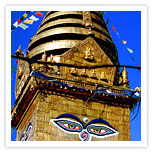 Day 06. POKHRA - KATHMANDU
Day 06. POKHRA - KATHMANDUAfter an early morning breakfast drive back to Kathmandu.
After checking in at the hotel the rest of the day is free to relax at the hotel or explore the city centre.
Stay overnight in Kathmandu.
Day 07. LEAVE KATHMANDU
Breakfast at the hotel and transfer to the airport in time to connect to the flight for onward destination.
another nepal
Well we finally left "the top of the world" Tibet and entered Nepal after a three hour wait to go thro' immigrations!!!! What a completetransformation from the barren desert bowl of Tibet and her mountains and into a lush green Alpine environment completewith waterfalls and other flora and fauna....
The border crossing into Nepal was a quick affair much to our relief!!! we then caught a public bus to Kathmandu, a whirlwind journey (of nine hours total!!! The bit they don't ever tell you before you do it) and our travelling companion from Tibet Jean Francois, bobbing about on top of the bus like a big kid!!! We arrived in Kathamandu finally in the evening and our first sighting was a city of lights as we entered civillisation at long last!!!
Left Kathmandu for Pokhora. A beautiful journey throughout the mountains passing by little villages en route. We spent the first evening eating by a beautiful lake and being entertained by traditional dancing girls (which Martin enjoyed very much as you can imagine!!). From here we left for Nayapul and began the first stages of our trek walking alongside the Modi river in a flat part of the valley, a relatively gentle introduction into trekking in Nepal with some ascending later on in the afternoon (phew!).
Day two, a little more hard core as even in the early morning (yes Martin managed to be up and out for 8am!!) the sun is already ablaze and the hills hot with the heat!!! We madeasteep ascent to Gandrung which had breathe taking scenery and was just amazing to observe the villages surrounding from our location on the mountain side. The views of the mountain ranges were just stunning and so majestic even at 1960m height. Our hotel room commanded the best views for morning time looking straight out onto Fishtail mountain, Machapuchre absolutely fantastic to wake up to first thing in the morning!!!
We made a couple of friends Colin and Jeanette whom were great fun and ended going on a mini tour of ther local village witht them and had a go at dressing up in the local Hill Tribe garb, well Jeanette and I did whilst Martin and Colin found it very funny!!! (see photo). We also sampled the local wine made from local home grown produce we cannot remember quite what as it was so potent!!!
From Gandrung we trekked on up to Tadapani, in the right season you are surrounded by Rhodedendron bushes but not for us! We then carried onto see some of the local waterfalls and pools, walking alongside the river and then hitting a high ridge, where we got to see Dhalagirir approx 8000m high. This day we ended up in Gorepani, where we had the most amazing views of the night time skies with many, many stars in the midnight sky against the Annarpurna range, fantastic!!! It was also where we had to pay our supposed fine to the Maoist terrorist people, in our case an average Nepalise kind of guy whom looked jut like all of the Trekking Guides, which was a tad worrying!!! We got discount as Jangbu sorted us out (good guy) Our receipt was signed "Robin" (which we thought quite apt). It is from here that many folk are tricked into getting up a stupid o'clock and trekking in the dark for about 40 minutes uphill to "Poon Hill", where you are pretty cold and hungry, but as the dark turns to light it is the most magical experience and well worth all the pain to watch the light constantly play and change over the mountain range. from "Poon Hill" we trekked downhill into the worlds deepest gorge which falls between Annarpurna South and Dhaulgirir into Tatapani village. Martin was a right girls blouse whinneying about his calves hurting, but it was a killer all the way down I have to say, even for a spring chicken like me!! Our perfect cure for soothing the aches and pains was to soak ourselves in the "Tatapani Hot Springs", complete with bar on the riverside,perfect!!!
You wake up to the smell of wonderful citrus fruits,Tatapani is a real citrus gowing region and we were surrounded by lemons the size of grapefruit I kid you not!! We carried on thro'a number of villages en route to Ghasa via a flat riverbed route. Itwas a surreal experience as we experienced many Hindu Indians, on a Pilgrimmage walk,(all way from India, a helluva long way) carrying very little heading onto the Tibetan border to Mount Kailaash (considered a very holy mountain), where we stayed overnight (the windiest place on earth!!) and met some really nice people, three girls from the UK who were pretty impressive, having carried their own packs all the way en route and "Wes" our cool american weather guy, and really interesting to talk to about stuff and a real nut about Mexico too (thanks for the tips Wes, we will definately go there!!).
On from Ghasa we head onto Larjung where the terrain really does begin to change from the Alpine greens to a more craggy barren like state of scenery. This part of our trek was walking on rocky paths, reaching Tukche, a small Tibetan village with wonderfully carved buildings. Our destination to Marpha which is higher up was a much livelier place in contrast. Here we sought out the Apple Brandy Distillery, surprise, surprise! It is well known for growing apples in the region, it was a really vibrant and buzzing place, the local guys in the distillery were quite entertaining and took us around whilst giving us a sample of the local brew, more like rocket fuel!!! It's a Buddhist village and many people come here for that apsect alone, you also get great views of the valley from the buddhist Temple set up on the hill. The local people are so friendly and like to help (as well as being after making some money from you!). The views of the mountains from here are limited but the colours wonderful, very autumnal. On the way Martin was attacked by a chicken (well rooster with a scraggy neck) I don't know what he had done to upset it but as I rounded the corner I saw Martin hitting it with his camera bag. Latter he explained that the sneaky poultry had jumped him from behind sinking his claws into his leg. Martin had shaken it off but it came back for a second go which was when it received the full force of his camera equipment.An old woman tossing hay on her rooftop nearly fell off with laughter! The next few stops on the trek were non eventful and passed thro' "Kagebeni" which is a very medieval village, from which you can see Nilgiri and Dhalgirir (big big mountain!). This place is full of nooks and crannies and has the biggest collection of both horses and buffalos/cows we have seen on route! as you come out of the village you glide up into a vast canyon which is quite striking to see and from here we headed past "Jarakot" (another medievil village) onto Muktinath a place sacred toHindu's and Buddhists alike. Hindus believe that bathing here gives salvation after death. In the Vishnu Temple there are 108 water spouts shaped as Boars head and a natural gas flame that's eternally lit. Thousands of pilgrims come here,all the way from India including Holy men!!
We made our way down to Johmson where we caught a flight back to Pokhara we had only seen the plane's while in the guest house near Poon hill. We all ducked as the first one came very close and nearly blew our breakfast off the table.
The tiny airport seemed to have more staff than required and once again the Tibetan Yak bone carvings caused problems with customs (yes on an internal flight) sure that Martin was smuggling something in them.
The plane back didn't seem like it had enough puff to get above the mountains so we just flew in between them. The weather was gorgeous as it had been for the whole two weeks.
Back in Pokhara we had a little wait as our guide Jangbu's box of oranges got left in Jomson proving the too many cooks theory. When the second plane turned up without them Jangbu gave a little "it's just Nepal" smile and we headed for our hotel and finally a hot shower (he got his oranges eventually).






























